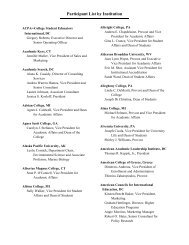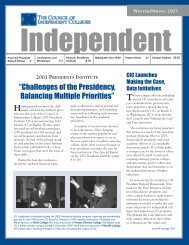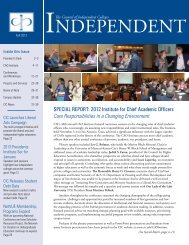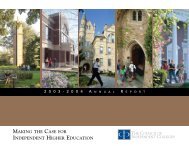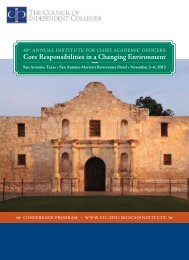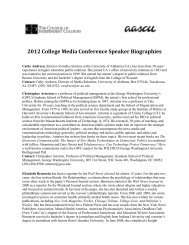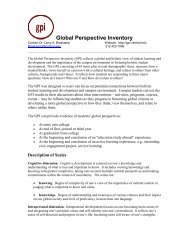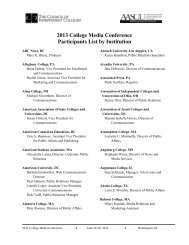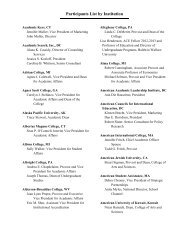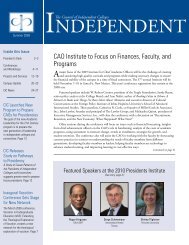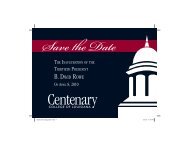Meeting the Challenge: - The Council of Independent Colleges
Meeting the Challenge: - The Council of Independent Colleges
Meeting the Challenge: - The Council of Independent Colleges
Create successful ePaper yourself
Turn your PDF publications into a flip-book with our unique Google optimized e-Paper software.
Small by Design: Resilience in an Era <strong>of</strong> Mass Higher Education<br />
Small private liberal arts colleges not only survived but thrived on <strong>the</strong>ir ability to<br />
Just before World War II, <strong>the</strong> flagship state universities <strong>of</strong><br />
Oregon, Colorado, Kansas, Georgia, and Virginia enrolled<br />
fewer than 6,000 students each. By 2000 most <strong>of</strong> <strong>the</strong>se<br />
institutions had enrollments <strong>of</strong> more than 20,000 on <strong>the</strong><br />
main campus, with thousands <strong>of</strong> additional students at<br />
<strong>the</strong>ir new branch campuses. <strong>The</strong> University <strong>of</strong> Minnesota<br />
alone grew from barely 1,700 students to more than 60,000<br />
students at its main Minneapolis and St. Paul campuses in<br />
less than a century.<br />
Such a quantitative change in higher education<br />
required a shift in educational philosophy. In 1949,<br />
Life magazine featured an article about <strong>the</strong> University<br />
<strong>of</strong> California. <strong>The</strong> president and dean stated that it was<br />
preferable to have 500 students in a lecture hall taught by<br />
<strong>the</strong> most notable scholar in <strong>the</strong> nation than to have smaller<br />
classes taught by scholars <strong>of</strong> lesser stature. Bear in mind,<br />
however, that <strong>the</strong>ir statement was a belief, not a research<br />
finding. Here was <strong>the</strong> philosophical difference that set small<br />
private colleges apart from <strong>the</strong> multiversity: college leaders<br />
believed that small class size, a small student body, and <strong>the</strong><br />
close interactions <strong>of</strong> campus life were important parts <strong>of</strong><br />
a sound undergraduate education. That commitment was<br />
crucial in shaping what <strong>the</strong> small independent colleges<br />
would—and would not—do in <strong>the</strong> late-20 th century.<br />
Although <strong>the</strong> commitment to smallness also began as a belief,<br />
we shall see that it has stood <strong>the</strong> test <strong>of</strong> rigorous empirical<br />
scrutiny by social and behavioral science researchers over <strong>the</strong><br />
decades since.<br />
<strong>The</strong> convictions about sound undergraduate<br />
pedagogy held at <strong>the</strong> small colleges meant, for starters, that<br />
<strong>the</strong>y could not accommodate a large share <strong>of</strong> <strong>the</strong> longterm,<br />
nationwide growth in college attendance. In 1950,<br />
undergraduate enrollments in <strong>the</strong> United States were almost<br />
evenly divided between institutions in <strong>the</strong> private and public<br />
sectors. By 1980 <strong>the</strong> public sector—including state colleges<br />
and universities as well as community colleges—enrolled<br />
about 79 percent <strong>of</strong> all undergraduates. This proportion has<br />
persisted into <strong>the</strong> 21 st century.<br />
One could infer from <strong>the</strong> data that <strong>the</strong> independent<br />
sector has declined in appeal and that students have<br />
shifted overwhelmingly to public institutions. Historical<br />
context suggests a different, more nuanced explanation<br />
for this statistical summary. Over <strong>the</strong> past five decades,<br />
enrollments in private institutions—a group that includes<br />
almost all small colleges—have shown healthy gains,<br />
doubling between 1950 and 1980. By 2001 independent<br />
colleges and universities enrolled more than three million<br />
students—about 23 percent <strong>of</strong> <strong>the</strong> national total for all<br />
degree-seeking students. Many small colleges, however,<br />
deliberately chose to remain relatively small for sound<br />
6



